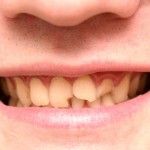
In the UK about one in five children have suffered traumatic dental injuries, usually to their anterior teeth before leaving school. Most injuries involve the crown of the tooth, but a range of difference injuries have been classified.
| Type of injury | Definition |
| Concussion | injury of the tooth-supporting structures without increased mobility or displacement of the tooth but with pain on percussion |
| Subluxation | injury of the supporting structures with increased mobility but without displacement of the tooth |
| Lateral luxation | lateral displacement of the tooth |
| Intrusive luxation | displacement of the tooth into the alveolar bone |
| Extrusive luxation | partial displacement of the tooth out of its socket |
| Avulsion | complete displacement of the tooth out of its socket |
The aim of this review was to assess the incidence of different types of root resorption after concussion, subluxation, lateral luxation, intrusive luxation, and extrusive luxation.
Methods
Searches were conducted in the Latin American and Caribbean Health Sciences (LILACS), PubMed/Medline), Scopus, Web of Science. Google Scholar, OpenGrey, and ProQuest databases. Independently by two reviewers. Screening of title and abstracts was carried out independently by two reviewers with studies assessing the incidence of different types of root resorption (external and internal) in human permanent teeth being included. Risk of bias for the included studies was assessed using the Meta-Analysis of Statistics Assessment and Review Instrument (MAStARI) critical appraisal tool for descriptive studies. Disagreements were resolved by a third reviewer. Studies were clustered into five groups according to the type of injury. Within each group, root resorption was classified as internal, surface, inflammatory, or replacement. The overall certainty of the evidence was assessed using the Grading of Recommendations Assessment, Development, and Evaluation (GRADE) tool.
Results
- 14 studies analysing 1988 teeth were included.
- Maxillary incisors were the most commonly affected teeth in all included studies.
- Age at time of injury ranges from 5 to 67 years.
- Root resorption was assessed on peri-apical radiographs.
- 14 studies reported external resorption 4 internal resorption.
- 488 immature and 1455 mature teeth were analysed across the 14 studies.
- The highest incidence rates of root resorption were observed for teeth with intrusive luxation.
Table showing summary of percentage of root resorption with different injury types
| Type of injury | Internal | Surface | Inflammatory | Replacement |
| Concussion | 0.0% | 0.0% | 0.0% | 0.0% |
| Subluxation | 1.54% to 1.72% | 1.54% to 8.33% | 0.0% to 12.5% | 0.0% to 4.17% |
| Lateral luxation | 0.0% to 1.45% | 0.97% to 16.67% | 0.0% to 80.26%. | 0.0% to 35.53% |
| Intrusive luxation | 0.0% to 22.2% | 0.0% to 4.76% | 1.1% to 92.86% | 0.0% to 57.14% |
| Extrusive luxation | 2.25% to 13.3% | 0.0% to 9.375% | 5.45% to 77.42% | 0.0% to 15.625% |
Conclusions
The authors concluded: –
Our findings suggest that root resorption is most commonly occurs in association with intrusive luxation and by inflammatory root resorption. Awareness regarding the incidence of RR after injuries is useful for clinicians to minimize the risk and severity of its occurrence, because a late diagnosis of root resorption may limit treatment alternatives and result in tooth loss.
Comments
An extensive database search has been conducted with all the review stages being conducted independently and in duplicate. As might be anticipated all the included studies are observational with follow up periods ranging from 2 months to 15 years although it is not clear whether the studies were prospective or retrospective in design. The authors highlight that no pooling of data was carried out because of the heterogeneity of the studies and poor definition of variables, so ranges of the percentages of different types of resorption are presented. The findings suggest that root resorption was more common in teeth that had suffered from intrusive luxation, followed by those with extrusive luxation, lateral luxation, subluxation, and concussion. However, the authors also highlight potential issues with root resorption classification criteria ,timing and type of treatment and that stage of root development was not always noted. So while this review provides a summary of the existing data careful collection of commonly agreed prospective data items would greatly facilitate future studies.
Links
Primary Paper
de Souza BDM, Dutra KL, Reyes-Carmona J, et al. Incidence of root resorption after concussion, subluxation, lateral luxation, intrusion, and extrusion: a systematic review. Clin Oral Investig. 2020;24(3):1101-1111. doi:10.1007/s00784-020-03199-3
Other references
Dental Elf – 15th May 2018
Dental Elf – 12th Jul 2019
